An IC, or Integrated Circuit, is a microelectronic device that integrates numerous small electronic components such as transistors, resistors, and capacitors into a single semiconductor substrate, typically a silicon wafer. ICs serve as the core of modern electronic devices and are widely used in various fields, including consumer electronics, industrial control, automotive electronics, and communication systems.
Types of ICs
ICs can be categorized based on their functionality and applications into the following types:
1. Analog Integrated CircuitsAnalog ICs process continuous signals, such as amplifying signals or managing power. Common examples include operational amplifiers, linear regulators, and power amplifiers.
2. Digital Integrated CircuitsDigital ICs handle digital signals and consist of logic gates. Examples include microprocessors, memory chips, digital signal processors (DSPs), and programmable logic devices (such as FPGAs).
3. Mixed-Signal Integrated CircuitsMixed-signal ICs combine analog and digital circuitry, making them ideal for communication and audio processing applications, such as Analog-to-Digital Converters (ADCs) and Digital-to-Analog Converters (DACs).
4. Application-Specific Integrated Circuits (ASICs)ASICs are tailored for specific applications, often found in high-performance scenarios like artificial intelligence chips and cryptocurrency mining processors.
IC Manufacturing Process
The manufacturing of ICs is a complex and precise process that includes the following steps:
1. Wafer FabricationThe wafer, the base material of ICs, is made from highly purified silicon. Techniques like chemical vapor deposition and epitaxial growth are used to produce high-quality silicon wafers.
2. PhotolithographyA layer of photoresist is applied to the wafer surface, and a photolithography machine exposes it to create the desired circuit patterns.
3. Ion Implantation and DiffusionSpecific chemical elements are introduced into the silicon to adjust its conductivity, forming transistors and other basic components.
4. Metal InterconnectionsMetals (like aluminum or copper) are used to connect different circuits, creating a complete IC structure.
5. Packaging and TestingThe wafer is diced into individual chips, which are then encapsulated to protect them. The chips undergo rigorous testing to ensure performance and quality.
Applications of ICs in Modern Society
The advent of ICs has revolutionized modern life. Here are some key areas of application:
1. Consumer ElectronicsDevices such as smartphones, computers, and smartwatches rely on ICs for their computational power and energy efficiency.
2. Automotive ElectronicsICs are integral to engine control units (ECUs), advanced driver-assistance systems (ADAS), and battery management systems (BMS) in electric vehicles.
3. Communication EquipmentICs form the backbone of 5G base stations, routers, and optical communication modules.
4. Industrial AutomationIndustrial control systems, including programmable logic controllers (PLCs) and inverters, leverage ICs for high-speed processing and reliability.
Emerging Trends in IC Technology
With ongoing advancements, the IC industry is moving in the following directions:
1. Shrinking Process NodesAdvanced nodes (like 3nm and 2nm processes) enable chips with higher integration, lower power consumption, and better performance.
2. Heterogeneous IntegrationCombining different functional chips (e.g., CPU, GPU, and AI accelerators) into a single package for optimized performance.
3. Silicon Carbide (SiC) and Gallium Nitride (GaN) MaterialsThese third-generation semiconductor materials excel in high-frequency and high-power scenarios, with applications in electric vehicles and photovoltaic inverters.
4. Artificial Intelligence ChipsAs AI continues to grow, dedicated AI chips (e.g., neural network processors) will see widespread adoption in data centers, edge computing, and smart devices.
Conclusion
ICs form the foundation of the modern electronics industry, driving the rapid evolution of information technology, communication systems, and automation. In the future, as new materials, processes, and architectures emerge, ICs will continue to lead technological revolutions and enable the global economy's digital transformation.

